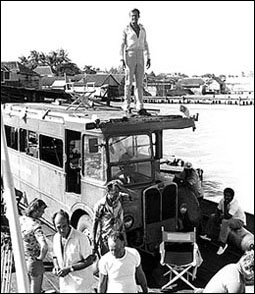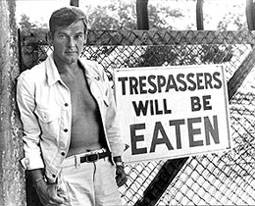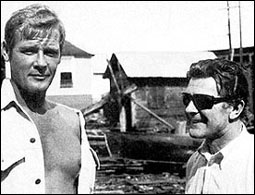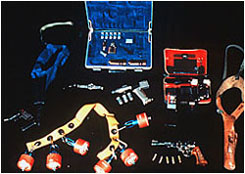 |
|
Roger Moore
atop the new ‘single-decker’ London bus. |
|
 |
|
Roger Moore
poses next to the sign that caught Syd Cain’s eye while on
location scouting in the West Indies. |
|
 |
|
Syd falls
‘victim’ to the irrepressible Roger Moore during location in
Jamaica for Live And Let Die (1973). |
|
 |
|
|
Do
you have any amusing anecdotes about any of the Bond films you have
worked on?
Well let me tell you a little story about Live And
Let Die and a crocodile. It wasn’t in the original script, but
the director Guy Hamilton and I were on a location trip in the West
Indies. Whilst in Jamaica I saw this sign saying ‘Crocodile Farm’,
which I thought sounded interesting and a big sign on the gate which
read ‘TRESPASSERS WILL BE EATEN’, which I thought was rather nice.
We went inside and saw the owner, a gentleman by the name of Ross
Kananga, and I asked Guy whether it might not be a good location to
use in the movie. We agreed it looked promising and that was how the
scene was developed where Bond jumps over the backs of the
crocodiles. Ross had over1,000 crocodiles and alligators on this
farm, and as you may recall in the film we had a small island
reached by a telescopic bridge, which had to be built by the film
crew. However, to build the island and the bridge you had to get
into the water, and I did ask if they would take the crocodiles out.
It took three weeks to clear the pond because Ross had to do it
himself, none of the locals would help (who can blame them – ed.)
but eventually we were given the all-clear that the men could go in
and work.
I had two typically British carpenters with me among
the crew engaged in building the bridge, and one of these ‘chippies’
was sawing away quite happily when suddenly I heard this tremendous
clap smack wallop, followed by a splash of water. What had happened
was that a huge alligator had appeared out of the mud, crawled up to
this ‘chippy’ and snapped at him. It was then that the ‘chippy’ very
coolly turned around and clouted the alligator with his saw. He told
it to fuck off and continued sawing, quite oblivious to the danger!
I managed to persuade him to have the rest of the day off while Ross
went looking for this rogue reptile. He in fact found two. They had
been buried under the mud and he had overlooked them during his
first search. The way he found the reptiles was quite interesting as
well. He would walk across the lake, which was quite shallow,
barefoot, and he could feel them under the mud with his feet!
Incidentally, the jumping on the backs of the crocodiles was done
for real by Ross Kananga. What we did was tie them down with
concrete blocks around their feet, but we left their heads and tails
free so they could react when we shot the scene. We also used a
special rubber solution on the soles of Ross’ shoes to give them
extra grip on the crocodiles’ backs. When Ross did it the first time
he in fact slipped and fell into the water, and there was a bit of a
panic over that. And on the fifth time he was actually bitten on the
heel of his shoe. Guy Hamilton said “Okay chaps, that’s enough of
that, it’s getting far too dangerous”, but Ross insisted on doing it
once again, but he said, of course now the crocodiles would be
expecting him. “Crocodiles are not stupid creatures, in fact they
are very intelligent”, Ross told us. The moment they felt him
running across their backs they made every attempt to snap at him.
It was on the sixth take that he managed to do the stunt, and that’s
the one you see in the finished film.
As
using the crocodiles in Live And Let Die and the mountain in
OHMSS were your suggestions, would you say that you’ve had
quite an influence on the look of the Bond films you’ve worked on,
not only in the design but in the conceptual ideas as well?
No more than any of the other Production Designers
who have worked on the Bond films really. All departments make
suggestions and it’s up to the Producers and Directors whether they
use the suggestion or not. |

